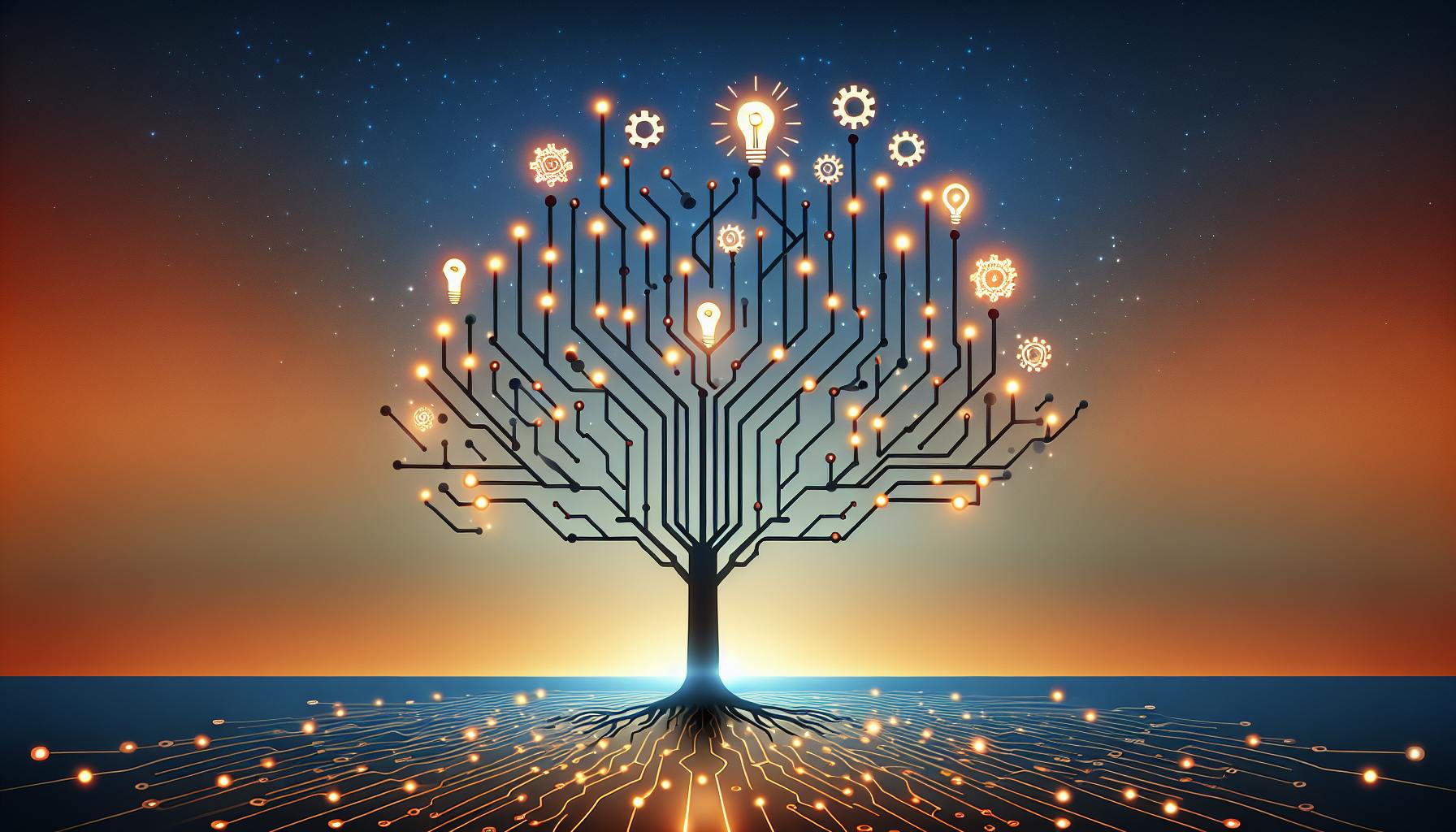We can all agree that leveraging AI assistants like ChatGPT is extremely valuable, but their capabilities are still limited.
By integrating open source AI libraries into ChatGPT, you can unlock more advanced skills like specialized knowledge, versatility, and customizations.
In this post, you'll discover the top open source AI projects for transforming ChatGPT into a more powerful assistant. We'll explore AI libraries for natural language processing, creativity, and more - with code examples in Python. You'll leave equipped to build your own customized open source AI chatbot.
Introduction: The Power of Open Source AI
chatgpt-users-guide/">Open source AI libraries allow us to tap into the transformative potential of AI like ChatGPT. By building on top of existing frameworks developed by the open source community, we gain more control, customizability, and transparency over our AI applications.
Unleashing ChatGPT's Potential with Free Open Source AI Libraries
ChatGPT comes with some built-in limitations around its capabilities and use cases. However, by integrating open source AI libraries into ChatGPT, we can overcome many of these constraints and truly unleash its potential.
Some key benefits of leveraging open source AI with ChatGPT include:
-
Customization: We can fine-tune ChatGPT models on specific datasets to improve performance for our unique needs. Open source libraries make this model tuning process more accessible.
-
Transparency: Access to model code and training data provides more visibility into how ChatGPT works behind the scenes. This transparency builds trust.
-
Community support: Open source projects have an engaged community of contributors and users. This allows us to get help and collaborate with others working on similar problems.
By combining the conversational prowess of ChatGPT with the versatility of open source AI, we open the doors to a wide range of possibilities for creating customized and capable chatbot solutions.
Gaining Flexibility and Control with Open Source AI Tools Like ChatGPT
Relying solely on ChatGPT's default model can be limiting. Open source AI tools allow us to adapt models like ChatGPT to our specific needs with more precision and control.
Some of the key advantages of open source AI tools include:
-
Custom training: We can further train ChatGPT models on niche datasets to improve performance on specialized tasks. Access to training code makes this achievable.
-
Modularity: Mixing and matching different open source AI model components gives us flexibility to build custom solutions. We can swap out modules to optimize performance.
-
Experimentation: The ability to tweak open source AI model architectures, hyperparameters, etc allows us to freely experiment and innovate.
-
Transparency: Open source code, data, and models provide visibility into how each AI component works behind the scenes. This builds trust.
Leveraging open source AI is the gateway to transforming ChatGPT from a fixed conversational agent into a versatile platform for creating highly-customized and specialized chatbots tailored to our needs.
Is there a free open source AI?
Open source AI refers to artificial intelligence systems and frameworks with open source licenses allowing them to be freely used, modified, and shared. There are many exciting open source AI projects providing powerful AI capabilities.
PyTorch and TensorFlow are two of the most popular open-source AI libraries used by researchers and developers for building machine learning models. Both offer open source Python frameworks optimized for deep learning and neural networks. The open source nature makes them highly customizable for tackling complex AI problems.
Smaller scale AI tools like Anthropic's Claude and AI21 Studio's Jurassic-1 are also fully open source. They can generate text and code to augment human capabilities, though without the conversational depth of ChatGPT.
While truly free in terms of access, larger foundation models like ChatGPT itself do incur significant compute costs. Providing open APIs does increase accessibility. However bandwidth usage requires monetization, making purely free access at scale infeasible. Most open source AI today focuses more on customization than end-user chatbots.
Nonetheless, the open source movement is enabling more decentralized, customizable and affordable AI development. With careful data usage and compute optimization, projects can balance openness with sustainability. The future points towards ever more powerful yet responsible open source AI possibilities.
What is the best library for AI?
There are several excellent open source AI libraries available today that offer powerful capabilities for building AI applications. Some of the most popular and widely-used options include:
Scikit-Learn - This Python library provides a range of machine learning algorithms and modeling tools like classification, regression, clustering, dimensionality reduction, model selection and more. It is simple and efficient to use, yet flexible enough for advanced applications. Scikit-learn is great for developers getting started with machine learning thanks to its comprehensive documentation and examples.
TensorFlow - Created by Google, TensorFlow is one of the leading open-source libraries for developing and training deep learning models. It offers tools for developing complex neural networks across a range of problem domains like computer vision, NLP, speech recognition, and more. TensorFlow is scalable, flexible, and allows easy deployment of models across platforms.
Keras - As a high-level API that runs TensorFlow, Keras makes it simpler to build, train and evaluate deep learning networks. It acts as an interface to TensorFlow and focuses on faster experimentation through user friendliness, efficiency, and extensibility. Keras is a great choice for fast prototyping and supports both convolutional and recurrent networks.
These open source AI libraries offer robust capabilities that can significantly enhance ChatGPT's skills. Whether you need task-specific intelligence or more advanced AI functionalities like computer vision or speech processing, leveraging libraries like TensorFlow, Keras or Scikit-Learn can unlock greater depth and versatility in your bot's conversational abilities. The open source nature makes them freely accessible to tailor to your needs.
What are the best open source AI agents?
Open source AI agents like Autogen, AutoGPT, and Baby AGI leverage large language models to offer powerful conversational abilities. Built on GPT-3.5 and the newly released GPT-4, these agents are more capable than ever.
As open source projects, they provide opportunities for developers and enthusiasts to build AI assistants customized for their needs. Their transparent nature also promotes trust in AI conversations.
Autogen
Autogen focuses on replicating a helpful assistant able to answer questions and hold conversations. Early testing shows promising results, with the agent displaying wit and nuance during discussions.
As an open source project, Autogen invites community contributions to improve conversational diversity. This collective effort helps produce well-rounded responses to queries.
AutoGPT
AutoGPT prioritizes user-friendliness, aiming to make AI accessible for everyone. The project focuses on developing an AI agent with strong language comprehension skills.
Built on GPT-4, AutoGPT handles complex instructions and multi-step reasoning. Its advanced language capabilities enable practical applications.
Baby AGI
Baby AGI sets ambitious goals of one day achieving artificial general intelligence (AGI). As an open source initiative, the project attracts AI experts passionate about pushing boundaries.
Built on a foundation of transparency, Baby AGI developers frequently share research updates. This openness allows the community to track progress towards AGI.
Open source AI conversational agents like these highlight the potential of platforms like ChatGPT. As their capabilities grow, integrating them can transform how we interact with AI.
Which library is used for AI?
NumPy is widely regarded as the best Python library for machine learning and AI. As an open-source library with many contributors, NumPy enables efficient numerical and mathematical operations on large multi-dimensional arrays and matrices.
Data scientists rely on NumPy to support the underlying computations for machine learning models. By facilitating rapid vectorization and broadcasting, NumPy helps optimize and accelerate machine learning workflows.
Some key reasons why NumPy stands out for AI development:
-
Vectorization - NumPy vectorizes operations, applying them to entire arrays without explicit looping. This provides significant performance gains.
-
Broadcasting - NumPy broadcasts smaller arrays into larger ones during operations, reducing memory needs.
-
Multidimensional arrays - NumPy uses fast, compact data containers to store multi-dimensional arrays, the core data structure for machine learning data.
-
Linear algebra functions - NumPy has a comprehensive set of linear algebra capabilities like matrix multiplication and decomposition - critical for neural networks.
-
Interoperability - NumPy integrates tightly with Python machine learning libraries like SciPy, Pandas, Scikit-Learn, Keras and PyTorch.
By leveraging NumPy's computational efficiencies, data scientists can build and train machine learning models faster. NumPy remains an essential open-source backbone for AI development with Python.
sbb-itb-b2c5cf4
Diving into the Best Open Source AI Projects
Open source artificial intelligence (AI) provides exciting opportunities to customize and extend ChatGPT's capabilities. By integrating open-source AI libraries and models, developers can create specialized chatbots tailored to specific use cases and industries.
Transformers: Best Open Source AI for NLP
The Transformers library by Hugging Face is one of the most popular open-source AI projects for natural language processing (NLP). It contains thousands of state-of-the-art NLP models like BERT, GPT-2, and T5 that can be fine-tuned on custom datasets.
Integrating Transformers models into ChatGPT unlocks more advanced NLP functionality like summarization, translation, question answering, sentiment analysis and more. For instance, a QA model from the Transformers library can empower ChatGPT to provide more accurate answers to domain-specific questions.
Developers can leverage the user-friendly Transformers API to quickly load models and utilize them for text generation or text classification. The library also simplifies training custom NLP models from scratch or fine-tuning existing ones.
Overall, Transformers is an invaluable open-source AI tool for creating more capable conversational chatbots aligned to specific business needs.
Leveraging Stable Diffusion: Open Source AI in Creativity
Stable Diffusion has emerged as a leading open-source AI system for image generation. This deep learning model can generate realistic images and art from text prompts.
Integrating Stable Diffusion into ChatGPT unlocks advanced text-to-image capabilities. Users can describe an image idea in text, and Stable Diffusion will generate it! This enhances ChatGPT's creative potential for graphic design, digital art, logo creation, etc.
For instance, prompt engineering techniques can help guide Stable Diffusion to render industry-specific images like product prototypes, building architecture plans, fashion sketches, and more.
Overall, Stable Diffusion illustrates the immense promise of open-source AI for powering next-generation creativity. Its integration with ChatGPT paves the way for more visually intelligent chatbots catered to creative professionals.
Advantages of Merging Open-source AI GPT Models with ChatGPT
Open-source AI libraries allow developers to customize and enhance ChatGPT's capabilities. By combining ChatGPT with open-source GPT models trained on niche datasets, we can create specialized chatbots tailored to our unique needs.
Specialized Knowledge through Customization
One of the main benefits of leveraging open-source AI is the ability to train models on custom datasets. Rather than relying solely on ChatGPT's general knowledge, we can teach our chatbot assistant more specialized skills by having it ingest domain-specific data.
For example, an open-source model trained on medical journals and case studies could provide ChatGPT with enhanced abilities to answer health-related questions. Or a model trained on legal documents may better equip ChatGPT to provide legal information. The possibilities are endless when we leverage publicly available AI model architectures and train them on whatever unique data we need.
By merging these customized open-source models with ChatGPT, we combine the versatility of our specialized knowledge with ChatGPT's advanced natural language capabilities. This empowers our chatbot to hold deeper conversations requiring niche expertise - a major advantage over vanilla ChatGPT alone.
Open Source AI for Enhanced Transparency and Control
Another key benefit is the increased transparency and control that comes with open-source AI libraries. Since the model code and training data is publicly accessible, developers can inspect the logic powering model predictions. This allows us to better understand strengths, weaknesses, and potential biases.
Moreover, the ability to customize the model architecture gives us greater control over output quality. We can fine-tune hyperparameters and make architectural tweaks to enhance reliability and safety. Features like classifier layers can also be added to constrain undesirable model behaviors.
This level of transparency and control is more difficult to achieve using proprietary services like ChatGPT. The fact that open-source models are customizable and inspectable makes them better suited for sensitive applications requiring accountability.
By combining open-source models with ChatGPT, we get the best of both worlds - advanced natural language capabilities meets customizable logic. This empowers developers to create highly reliable chatbots tailored to their unique needs.
Utilizing AI Libraries Python Coders Love in ChatGPT
Python is a popular language for AI development due to its simplicity and vast ecosystem of open-source libraries. Integrating these into ChatGPT conversational flows unlocks exciting possibilities.
Seamless Integration with Lightweight Python AI Libraries
ChatGPT provides a flexible API for integration with external AI systems. Python libraries like HuggingFace Transformers make this easy with no backend infrastructure required.
Simply load a pretrained model and write a Python script to handle the API calls. For example:
import chatgpt
# Load model
model = AutoModel.from_pretrained("model_name")
# ChatGPT API call
response = chatgpt.send_message("Hello!", model=model)
# Return response
print(response)
This enables seamless integration to enhance conversations with domain-specific knowledge or personalized responses. Some popular open source Python libraries include:
- HuggingFace Transformers - State-of-the-art NLP & CV models
- PyTorch - Powerful machine learning framework
- Tensorflow - End-to-end platform for machine learning
- Scikit-Learn - Classic ML algorithms & analysis tools
The simplicity of Python combined with these robust AI libraries offers unlimited potential to customize ChatGPT to your needs.
Open Source AI Models in Containerized Microservices
For more complex integrations, Docker provides an ideal way to containerize open source AI models into microservices. Containers isolate dependencies and system configurations for smooth deployment with ChatGPT.
Key advantages include:
- Portability - Containerized models work across systems and environments
- Scalability - Easily spin up multiple containers to handle traffic
- Reliability - Robust separation of components prevents crashes
- Agility - Quickly build, ship and update AI integrations
Here is a sample Dockerfile for an AI microservice:
FROM python:3.8-slim
COPY . /app
WORKDIR /app
RUN pip install -r requirements.txt
EXPOSE 5000
ENTRYPOINT [ "python", "app.py" ]
This structured approach enables enterprise-grade integration of open source AI innovations into ChatGPT while maintaining stability.
Overall, Python's versatility combined with open source libraries and containerization solutions offer programmers an exciting sandbox for creativity in enhancing ChatGPT capabilities.
Showcase: Open Source AI Chatbot Innovations
This section highlights real-world open source AI chatbots built with tools like Rasa and Transformers that demonstrate the possibilities of open source ai libraries.
Clara: A Revolutionary Open Source AI Chatbot for Customer Support
Clara is an innovative virtual assistant for customer service powered by the open-source Rasa framework. As an example of free open source AI, Clara handles common customer queries and escalates complex issues to human agents.
Key features include:
- Natural language understanding with AI libraries Python like Rasa NLU
- Conversational flows built with open source tools
- Easy integration with business systems via API
- Active development community improving Clara daily
Clara shows how open source AI chatbot projects can transform customer support. Her sophisticated capabilities and affordable implementation demonstrate the potential of community-driven AI advancements. Clara is leading the way in open source virtual assistants.
Codex: The Open Source AI Programming Assistant
Codex assists developers by providing relevant code snippets and explanations using open-source AI tools like GPT-3. It exemplifies how focused open source AI tools like ChatGPT can enhance productivity.
Benefits of Codex include:
- Intelligent code suggestions for faster development
- Natural language explanations of code samples
- Complements existing workflows as an open source AI aid
- Easy to deploy and modify as an open source project
As an open-source ai gpt solution, Codex shows the utility of AI in practical applications. Its public availability also enables community contributions to improve it over time. Codex represents the collaborative potential of open source AI projects in specialized domains.
Overall, these open source AI chatbots showcase what’s possible when leveraging best open source AI tools. Their innovative capabilities and active developer communities push the boundaries of AI advancement. They represent a glimpse into the future democratization of AI technology.
Harnessing Open Source AI Tools: Conclusion and Reflections
Open source AI libraries offer expansive potential to enhance ChatGPT interactions. By integrating tools like Transformers and Stable Diffusion, we can add advanced capabilities and customization. However, with great power comes great responsibility.
As we close, let's recap key insights and reflect on how we can harness open source AI responsibly.
Exploring the Horizon of Open Source AI Projects
Numerous open source AI projects enable all sorts of possibilities:
-
Language models like GPT-3 and Codex translate text and code with human-like fluency. They expand ChatGPT's skills for writing, translation, summarization, and more.
-
Stable Diffusion generates images from text prompts, unlocking ChatGPT's creativity for art, logo design, etc.
-
Other libraries specialize for areas like computer vision, voice, robotics, and beyond.
Integrating these tools, we can customize precisely the ChatGPT enhancements we need. The horizon is expansive.
From Python Wrappers to Microservices: Integrating Open Source AI with ChatGPT
On the technical side, open source AI integrates through:
-
Python wrappers make libraries easily callable. By pip installing transformers, stable-diffusion-pytorch etc. we enable Python scripts to orchestrate ChatGPT conversations powered by those models.
-
Docker containers package code, libraries, models into stand-alone microservices. We can deploy them separately from ChatGPT, connecting via APIs. This provides flexibility to scale.
-
Webhooks allow sending data between services. We can call open source AI tools to analyze ChatGPT's messages, then return insights to enrich the conversation.
Integrating responsibly requires planning. But done well, combining open source AI unlocks ChatGPT's full potential.
The path ahead promises to be both transformative and challenging. But by learning from each other, we can build an AI future that benefits all.


